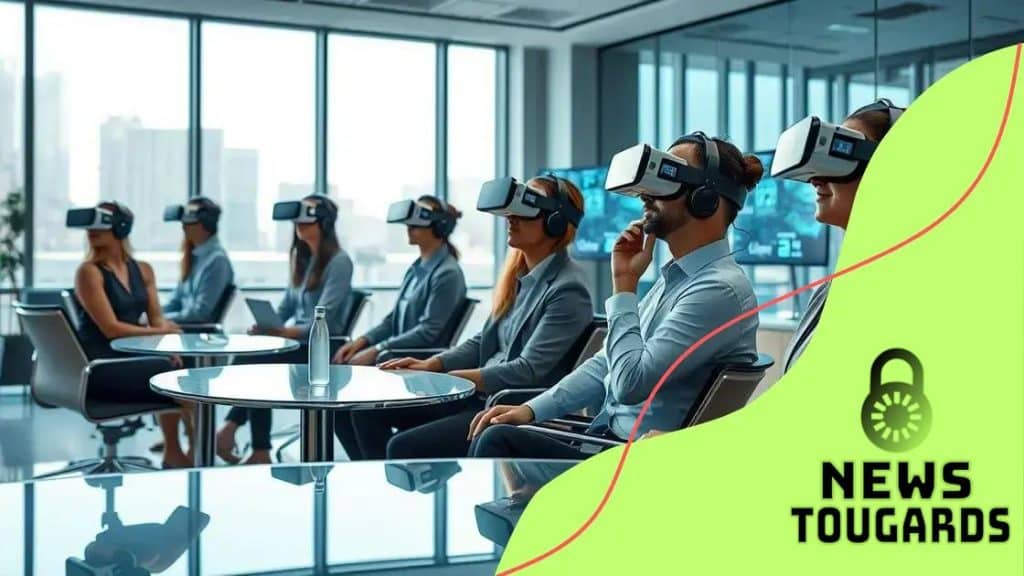The evolution of virtual reality in professional training

The evolution of virtual reality in professional training is revolutionizing education by providing immersive, interactive experiences that enhance learning, engagement, and skill retention across various industries.
The evolution of virtual reality in professional training is redefining how we approach skill acquisition and development. Imagine stepping into a completely immersive environment where learning comes to life. Curious about its impact? Let’s dive in!
Understanding virtual reality technology
Understanding virtual reality technology is crucial for grasping its impact on professional training. Virtual reality, or VR, creates an immersive environment where users can interact with 3D worlds. This technology is transforming how skills are taught and learned by placing learners in realistic scenarios.
What is Virtual Reality?
At its core, virtual reality involves the use of headsets and sensors that track the user’s movements. When using VR, individuals can manipulate objects and navigate through various environments as if they were truly present. This active participation enhances memory retention, making learning more effective.
Key Components of VR Technology
Several key components make up virtual reality technology. These include:
- Hardware: The equipment needed, such as headsets and controllers.
- Software: Programs that create immersive environments and experiences.
- Sensory Feedback: Feedback systems that engage the senses, providing a more realistic experience.
As we explore how virtual reality in professional training is used, it is essential to note that this technology not only promotes engagement but also encourages safe learning environments. For example, trainees can practice high-risk procedures without real-world consequences.
The integration of VR into training also facilitates remote learning. With VR, trainers and learners can connect in virtual spaces, breaking down geographical barriers. This flexibility opens doors for collaboration and knowledge sharing that weren’t previously possible.
Future of VR Technology in Training
Looking ahead, the future of virtual reality technology in professional training is promising. As the technology advances, we can expect more realistic scenarios and improved interactions. With ongoing research and development, VR will continue to evolve, providing even more tools for effective learning.
Benefits of VR in professional training
The benefits of VR in professional training are numerous and significant. This technology not only enhances engagement but also improves retention of information. Learners find themselves immersed in realistic scenarios that mimic real-life situations they will encounter in their jobs.
Enhanced Learning Experience
One of the primary benefits of using VR in training is the rich learning experience it provides. Participants can practice skills in a controlled environment without the fear of negative consequences. For example, medical trainees can perform surgeries in VR before working on real patients.
Key Benefits of VR in Training
Incorporating virtual reality into training offers various advantages:
- Increased Engagement: The immersive nature of VR keeps learners focused and motivated.
- Better Retention: Realistic simulations help improve memory and recall of learned information.
- Cost-Effectiveness: Reducing the need for physical materials or travel can lower training costs.
Moreover, VR allows for personalized learning experiences. Each learner can progress at their own pace, revisiting challenging tasks as needed. This adaptability is key for effective training.
By using VR technology, trainers can obtain immediate feedback. Users can make mistakes in a safe environment, learning from them in real-time. This instant evaluation encourages skill refinement and boosts confidence.
Applications Across Industries
The applications of VR span numerous industries including healthcare, aviation, and manufacturing. Each sector benefits uniquely from the immersive training opportunities that VR offers. In healthcare, simulations train professionals for emergency situations. In aviation, pilots practice in flight simulators that resemble their actual cockpits.
Real-world applications of VR training

Real-world applications of VR training are transforming various industries by providing immersive learning experiences. These simulations create opportunities for hands-on practice in a safe environment, making training more effective and memorable.
Healthcare Training
In the healthcare field, VR is used extensively to train medical professionals. It allows doctors and nurses to practice procedures in a virtual setting, honing their skills before treating real patients. By simulating surgeries, healthcare practitioners can improve their proficiency without putting lives at risk.
Emergency Response Training
When it comes to emergency responders, VR training helps them prepare for high-pressure situations. Firefighters, police officers, and paramedics can experience realistic scenarios, such as natural disasters or active shooter situations. This prepares them for real-life emergencies.
Military Training
The military also utilizes VR to train soldiers. Instead of traditional methods, they engage in virtual combat scenarios. This technology allows them to strategize and react to various situations without any physical harm.
The manufacturing industry benefits from VR as well. Workers can learn how to operate machinery and follow safety protocols through immersive simulations. By practicing in a virtual environment, they become more confident and capable in their roles.
Moreover, VR is revolutionizing the field of aviation. Pilots can train on flight simulators that mirror the actual cockpit and flying conditions. This allows them to gain experience and prepare for unforeseen circumstances.
Corporate Training and Development
In the corporate world, VR is enhancing employee training programs. Companies use this technology to conduct role-playing exercises and enhance managerial skills. Employees can develop their skills in a realistic yet risk-free setting.
Challenges in implementing VR training
Challenges in implementing VR training can hinder the full potential of this innovative technology. While the benefits are significant, several obstacles must be addressed for successful adoption in various industries.
High Initial Costs
One major challenge is the high initial costs associated with virtual reality equipment and software. Organizations may hesitate to invest in VR technology due to the expense of purchasing headsets, developing custom content, and maintaining the systems.
Technical Issues
Another obstacle comes from technical difficulties that can arise during implementation. Not all users may have the necessary technical skills to operate VR systems effectively. This can lead to frustrations and limited usage.
Training and Support
Providing adequate training and support for staff is essential, yet it often proves challenging. Companies need to ensure that employees are comfortable using VR technology. Without proper training, the benefits of VR training may not be fully realized.
Furthermore, integration with existing training programs can pose a challenge. Organizations must find ways to align VR training with current practices. Leading to a seamless experience for users.
Space and Equipment Limitations
Physical space is also a consideration. VR setups typically require adequate room for movement. Companies with limited space may find it difficult to implement training solutions effectively.
Despite these challenges, VR training can be highly effective when properly implemented. Addressing these issues with thoughtful planning can lead to a successful integration of VR technology in various sectors.
Future trends in virtual reality for education
Future trends in virtual reality for education are promising, showing how this technology can continue to transform learning environments. As advancements occur, we expect to see even more innovative applications that enhance learning experiences.
Increased Accessibility
One major trend is the push for increased accessibility. Education systems are working to make VR technology available to more students. This includes creating affordable VR tools and apps that can be used in classrooms around the world.
Integration with Artificial Intelligence
Another exciting trend is the integration of artificial intelligence with VR. By combining these two technologies, personalized learning experiences will become more attainable. AI can adapt VR scenarios to fit individual students’ needs. This custom approach helps in maximizing learning outcomes.
Collaboration and Social Learning
Moreover, future VR technologies will likely emphasize collaboration and social learning. Virtual classrooms may allow students from different locations to work together in real-time. This fosters communication skills and teamwork while providing a global perspective on various subjects.
The development of multi-user environments will enable students to learn alongside their peers, enhancing engagement. These interactive setups can stimulate discussions and inspire creativity, making the educational experience richer.
Focus on Lifelong Learning
Additionally, there is a growing emphasis on lifelong learning through VR. As professionals seek to upskill or change careers, VR can provide effective training programs that cater to adults. This will allow individuals to continue their education in a flexible and engaging manner, adapting to their busy lifestyles.
Content Creation and User-generated Learning
As more users become familiar with VR technology, expect to see an increase in user-generated content. Educators and students alike will likely contribute their own VR experiences. This trend not only democratizes content creation but also enriches learning materials and perspectives available to others.
\n
FAQ – Frequently Asked Questions about Virtual Reality in Education
What are the main benefits of using VR in education?
The main benefits include increased engagement, improved retention of information, and the ability to practice skills in a safe environment.
How does VR technology enhance learning experiences?
VR technology offers immersive simulations that allow students to interact with virtual environments, making learning more interactive and enjoyable.
What challenges might schools face when implementing VR training?
Challenges include high initial costs, technical difficulties, and the need for adequate training and support for staff and students.
What trends can we expect to see in the future of VR for education?
Future trends include increased accessibility, personalized learning through AI, and enhanced collaboration among students in virtual classrooms.





